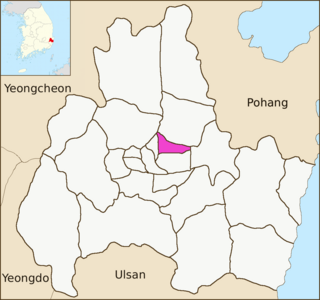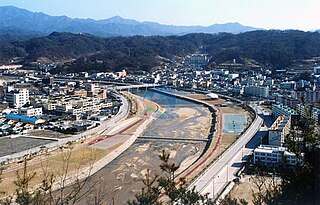
Yeongju is a city in the far north region of North Gyeongsang province in South Korea, covering 668.84 km2 with a population of 113,930 people according to the 2008 census. The city borders Bonghwa county to the east, Danyang county of North Chungcheong province to the west, Andong city and Yecheon county to the south, and Yeongwol county of Gangwon province to the north.

Jeungpyeong County (Jeungpyeong-gun) is a county in North Chungcheong Province, South Korea.

Uiwang is a city in Gyeonggi Province, South Korea. It is one of many satellite cities that ring Seoul, making up the Seoul National Capital Area. Its largest immediate urban neighbor is Anyang. The low peaks of the Gwangju Mountains shape the local landscape.

Bonghwa County (Bonghwa-gun) is a county in North Gyeongsang Province, South Korea. It lies inland, at the northern edge of the province, and borders Gangwon province to the north. To the east it is bounded by Yeongyang and Uljin counties, to the south by Andong, and to the west by Yeongju. The county is ringed by the Taebaek and Sobaek Mountains, the highest of which is Taebaek-san itself, at more than 1500 meters above sea level. Because of this mountainous inland location, Bonghwa has a colder climate than most of the province, with an average annual temperature of 10 °C (50 °F).

Haman County (Haman-gun) is a county in South Gyeongsang Province, South Korea. The local government is seated in Gaya-eup. The county magistrate is Seok Gyu Jin.

Samseong-Dong is an affluent neighborhood or ward of Gangnam-gu in Seoul, South Korea.

Sannae-myeon is a myeon or a township in the subdivision of Gyeongju City, North Gyeongsang province, South Korea. Its 142.64 square kilometers are home to about 3,624 people. This population is served by one elementary school, two branch schools and a kindergarten affiliated with the elementary school, and one joint middle-high school.

Seo-myeon is a myeon or a township in the subdivision of the Gyeongju City, North Gyeongsang province, South Korea. It is bordered by its neighborhoods including Hyeongok-myeon and Geoncheon-eup on the east, Sannae-myeon on the south and Yeongcheon City on the west and north. Its 52.12 square kilometers are home to about 4,166 people. This population is served by one elementary school and one joint middle school.

Hyeongok-myeon is a myeon or a township in the administrative subdivisions of the Gyeongju City, North Gyeongsang province, South Korea. It is bordered by Hyeongsan River, Cheonbuk-myeon and Yonghwang-dong on the east, Bodeok-dong on the south and Geoncheon-eup on the southwest, Seo-myeon on the west and Angang-eup on the north. Its 55.74 square kilometers are home to about 13,658 people. This population is served by three elementary schools, one middle school and one high school.

Yangbuk-myeon is a myeon or a township in the administrative subdivisions of the Gyeongju City, North Gyeongsang province, South Korea. It is bordered by Gampo-eup and Sea of Japan on the east, Yangnam-myeon on the south, Bulguk-dong, Bodeok-dong and Oedong-eup on the west and Ocheon-eup and Janggi-myeon of the Pohang city on the north. Its 120.06 square kilometers are home to about 4,558 people. This population is served by one joint elementary-middle school.

Yonggang-dong is both an administrative and legal dong or a neighbourhood in the administrative subdivisions of the Gyeongju City, North Gyeongsang province, South Korea. It is bordered by Bukgun-dong on the east, Deoksan-ri of Cheonbuk-myeon on the northeast, Hwangseong-dong and Dongcheon-dong on the south and Geumjang-ri of Hyeongok-myeon on the south. Its 5.06 square kilometers are home to about 15,817 people. It has two elementary schools, a middle school and a high school
Sangun-myeon is a myeon or a township in Bonghwa county of North Gyeongsang province in South Korea. The total area of Sangun-myeon is 58.52 square kilometers, and, as of 2006, the population was 2,070 people. Sangun-myeon is further divided into eight "ri", or small villages.
Myeongho-myeon is a myeon or a township in Bonghwa county of North Gyeongsang province in South Korea. The total area of Myeongho-myeon is 114.38 square kilometers, and, as of 2006, the population was 2,428 people. Myeongho-myeon is further divided into eight "ri", or small villages.
Socheon-myeon is a myeon or a township in Bonghwa county of North Gyeongsang province in South Korea. The total area of Socheon-myeon is 264.17 square kilometers, and, as of 2006, the population was 2,519 people. Socheon-myeon is further divided into seven "ri", or small villages.
Murya-myeon is a myeon or a township in Bonghwa county of North Gyeongsang province in South Korea. The total area of Murya-myeon is 109.26 km2 (42.19 sq mi), and, as of 2006, the population was 3,518 people. Murya-myeon is further divided into eight "ri", or small villages.
Jaesan-myeon is a myeon or a township in Bonghwa county of North Gyeongsang province in South Korea. The total area of Jaesan-myeon is 126.01 square kilometers, and, as of 2006, the population was 1,692 people. Jaesan-myeon is further divided into five "ri", or small villages.
Bongseong-myeon is a myeon or a township in Bonghwa county of North Gyeongsang province in South Korea. The total area of Bongseong-myeon is 66.69 square kilometers, and, as of 2006, the population was 2,583 people. Bongseong-myeon is further divided into seven "ri", or small villages.
Beopjeon-myeon is a myeon or a township in Bonghwa county of North Gyeongsang province in South Korea. The total area of Beopjeon-myeon is 70.22 square kilometers, and, as of 2006, the population was 2,368 people. Beopjeon-myeon is further divided into seven "ri", or small villages.
Chunyang-myeon is a myeon or a township in Bonghwa county of North Gyeongsang province in South Korea. The total area of Chunyang-myeon is 167.28 square kilometers, and, as of 2006, the population was 5,154 people. Chunyang-myeon is further divided into nine "ri", or small villages.

Bonghwa is a town, or eup in Bonghwa County, North Gyeongsang Province, South Korea. The township Bonghwa-myeon was upgraded to the town Bonghwa-eup in 1979. Bonghwa County Office and Bonghwa Town Office are located in Naeseong-ri, which is crowded with people.












